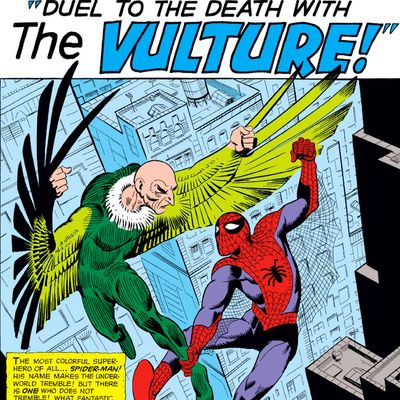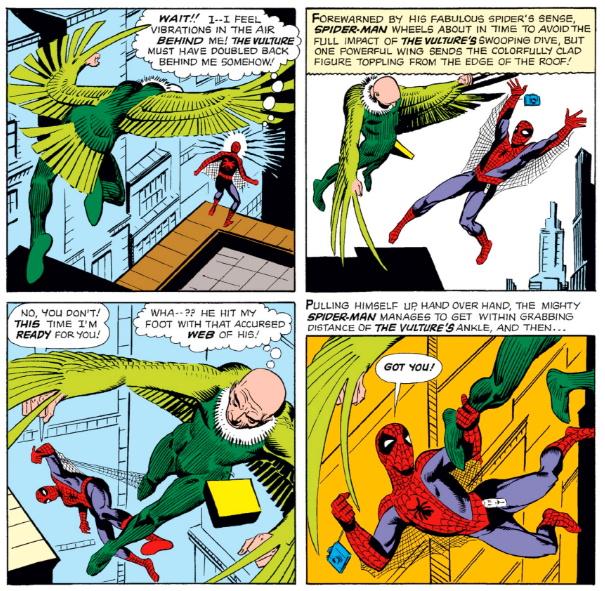
The earliest adventures of the world’s greatest superheroes often feature villains who have ended up more or less lost to time. Superman’s first foe was a random domestic abuser. Batman initially took on forgettable threats like a generic mad scientist named Stryker and something called the Dirigible of Doom. And who can forget early X-Men enemy Unus the Untouchable? (Answer: virtually everyone.)
Spider-Man is an exception in this regard. In the second issue of his solo series, The Amazing Spider-Man, he defeated a sinister foe by the name of the Vulture, and that guy has been a Spidey staple ever since. Indeed, when Marvel and Sony planned their reboot of the Spider-Man movie franchise with 2017’s Homecoming, they chose to make the Vulture — played by Michael Keaton — the film’s antagonist.
That kind of exposure would have been more or less unimaginable for the Vulture’s co-creators when they brought him to life in early 1963. He was the high-flying brainchild of writer-editor Stan Lee and writer-artist Steve Ditko, and like most villains of that era’s comics, he was little more than a set of visuals built around a flimsy gimmick. Lee and Ditko had conceived of and debuted Spider-Man just a few months before in an anthology comic, and the webslinger was a surprise hit for their employer, Marvel Comics — of which Lee was the longstanding editor-in-chief. Lee decided to spin their arachnid hero into his own solo title, The Amazing Spider-Man. In it, Lee and Ditko hit the ground running right from their delightful first batch of issues. The first one saw their title character meet the Fantastic Four, save an astronaut, and meet a foe named the Chameleon — but the next chapter was even more colorful.
Issue number two’s lead story was titled, with classic Lee bombast, “Duel to the Death With the Vulture!” and its opening page depicted the wall-crawler gripping the ankle of an elderly, bald man wearing a green bird costume. They were suspended in midair, the vertiginous skyscrapers of Manhattan surrounding them, and Spidey was undertaking the unenviable task of punching the man who was keeping him aloft. “What fantastic power can The Vulture have which makes him so sure he can defeat … Spider-Man?” the narration box asked, rhetorically.
That title page promised a vicious battle, but a different kind of clash had preceded the debut of this new nemesis. The infamously reclusive Ditko has refused all interview requests since 1968, but he periodically pens essays (available only via mail order) about his experiences at Marvel. In 2002, he published one about the creation of The Amazing Spider-Man No. 2, and it claimed that there was trouble in paradise even at that early stage in Spidey’s development. One of the prompts for Ditko and Lee’s squabbling was the creation of the Vulture.
As was the custom for Marvel’s workflow in that period, Lee didn’t provide Ditko with a script for issue two, but rather with a loose synopsis of what would transpire in the issue; Ditko crafted the story visually, using the synopsis as a springboard, then brought his pages back so Lee could add dialogue, narration, and sound effects. Lee wanted to introduce an avian bad guy named the Vulture, so Ditko naturally assumed the character should be as lean and ugly as the bird after which he was named. Lee disagreed.
“Stan believed the most effective villain was the heavy-set one,” Ditko wrote in his 2002 essay. “He once mentioned the movie villain, Sydney Greenstreet, as a villain model. So Stan didn’t like my thin, gaunt Vulture.” Ditko felt that massive antagonists have their virtues, but that they can often seem “physically passive.” As he put it, “An elephant’s bulk can be frightening and destructive, but it is easier to escape from than the lean, fast cheetah.” What’s more, a large figure can be frustrating for page composition: “The bulkier anything is, the more panel space it has to take up, thereby shrinking panel space for other characters and story panel elements.”
Ditko doesn’t recount whether he told Lee all of that, and indeed, as is often the case with Ditko, his essay offers us precious few details on how their disagreement played out. Add to that the fact that Lee hardly ever does interviews anymore, and one is left with a frustrating lack of specifics about how they resolved their differences. But it appears that Lee allowed himself to be overruled, because the sinister soarer that readers met was, indeed, a withered and brittle-looking fellow.
“For days, a new and ominous danger has menaced the vast city of New York!” the narration on the first panel of the second page declares. “Without warning, without the slightest sound, he strikes!” Below, a suited man walks the pavement with a suitcase, unaware of the massive silhouette of a vulture that has draped itself over him. Suddenly, the flying fiend from the title page swoops down and steals the briefcase. Onlookers are stunned and horrified: “How can he fly — without a sound — without any effort!” one pedestrian muses to himself. “He’s more like a gigantic bird of prey than a human!”
It’s worth noting that Marvel had scarcely any heroes who could fly — Superman resided over at DC Comics — so these civilians could very believably be awed by an airborne attacker. Thus, in a few short panels, the stakes have been set: There’s a jerk in green feathers terrorizing the Big Apple, and everyone knows about him.

The subsequent story is more than a little ridiculous. The superhero genre was much blunter in the early ‘60s than it is today, with characters telegraphing everything they were thinking at all times and working from thin motivations. For example, Vulture flies away from his secret lair on a mission to steal some diamonds (“my ingenious plan!” is how he characterizes it in his internal monologue), then muses on the fact that no one will know how to stop him because they don’t know the secret of his artificial wings. By chance, Spidey sees him from a rooftop and declares, “What luck! It’s the Vulture!”
The baddie kicks Spidey in the head before they can fight in earnest, then drops his unconscious spider-body into a water tower. Though our hero escapes, he’s too late to stop the Vulture from stealing the diamonds. Spider-Man catches up to him, of course, and they have it out. Spidey busts out a device he built that disables the Vulture’s flight powers (none of the science is explained, even in vague terms) and the old man falls toward the ground. This was a comic for kids, of course, so Spider-Man self-monologues, “As for the Vulture, he’ll manage to break his fall by spiraling down,” so we know no vultures were killed in the making of this story. The cops find him and ridicule him; he sits there and cries, “Please — no jokes!”, and then goes to jail, where, for some reason, he still wears his costume.
All in all, that first Vulture story wasn’t much of a hall-of-famer, but it’s a decent example of the creative ferment out of which characters came back in those days. The villains were especially wild back then, because they usually only stuck around for one issue at a time, as serialized narratives were still a rarity in the comic-book medium. That meant the baddies were often based on a single gimmick and lacked any kind of layering or pathos. That was very much true of the Vulture. We learn basically nothing about him in this first story, other than that he’s evil, avaricious, and avian.
And yet, precisely because the characterization was so threadbare, the visuals were all the more important. It was Ditko’s job to not only plot out the story, but to make its antagonist interesting when there was so little to him. In that regard, Ditko’s instincts about body shape were on the money. There were plenty of bulky, muscular, and virile villains out there, but precious few who looked as desiccated as this new figure. He would return for better plots in the future, but one thing that never changed was the fact that he was always more cheetah than elephant.




